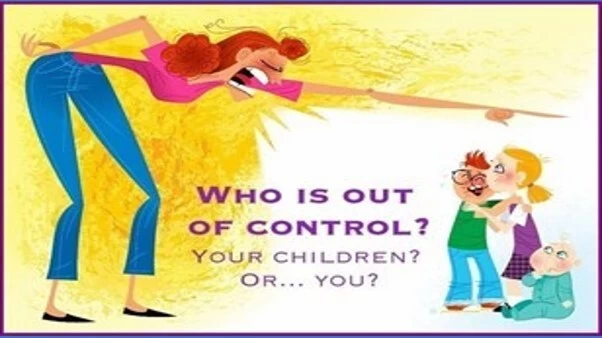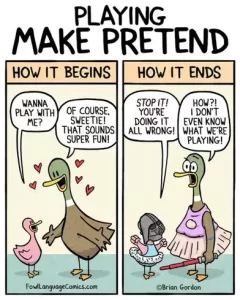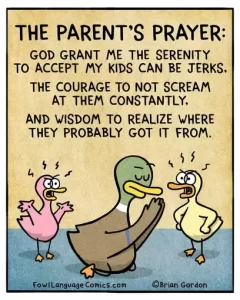
DON’T THINK THAT JUST BECAUSE THEY ARE PRE SCHOOL AGE THEY WON’T PUSH YOUR BUTTONS… You’ve yelled at your child, and perhaps their behavior led you to that reaction, but the starting point is getting your own behavior in check before trying to get your kids’ behavior in check.
Children rely heavily on their parents for learning and distinguishing between right and wrong. If a child or teenager perceives anger and aggression, such as shouting or screaming, as “normal behavior,” their conduct will mirror that in each area of their lives.
If you adhere to the following, you will accomplish new skills and less yelling. Good Luck!
IDENTIFY ACTIONS AND REACTIONS
There are numerous strategies that can assist you with restructuring the way your child behaves. The flip side to that is your behavior has to be in alignment with the techniques and strategies you are trying to implement. Instead of focusing on your child’s conduct, consider what is going on in your life right now.
Paying attention to those sensations that bring about heightened emotions, while looking for patterns in your reactions, is the key to finding your triggers. Being self-aware can make all the difference in shifting the trajectory of your family for the better.
When you know that you are about ten seconds from exploding then you need to find a way to recalibrate. Your intentions towards your children should always be one of love and safety. Understanding your own emotional intelligence will help when your feelings towards your child may not be so nice. It also helps you to see and understand others’ emotions.
Here are some methods to calm yourself in the heat of the moment:
– Talking to another person can shift your mood
– Acknowledge what is happening without self criticising or accepting criticism from others
– Have an attitude of gratitude. Be grateful for what is in your life
– Go outside. Breathe in the fresh air
– Do things that are good for you and good to you

LEADING BY EXAMPLE
Imagine your kid is watching their favorite YouTube show on a phone. It is getting closer and closer to bedtime, and you decide it’s time for them to stop watching the phone because it will undoubtedly cause them to have a restless sleep. So you walk up to them, tell them it’s time to turn off the device, and you take it out of their hands. This is met with uncontrollable crying and misery from your already-tired young child. Your frustration rises because you know you’re doing what’s best for them.
The first thing that went wrong was a lack of communication. Just like us, young kids want to hear and want to be heard.
When your child loses it and exhibits extreme forms of emotions, they are giving you a second chance to listen!
Remember, you are entitled to your emotions (whatever they may be), but you are not permitted to vent your rage on others, regardless of their actions. REMEMBER TO RESPOND NOT REACT

WAIT FOR THE FEELING TO PASS
When you feel triggered, it’s okay to step away and come back at a later time to chat with your child about inappropriate language, conduct, or behavior. It can be within ten minutes or even the next day. It’s best to use up your energy doing something else rather than retaliating with nasty words or yelling in response to whatever your child has done.
Kids are not dogs who need to be reprimanded immeiately for their bad behaviour
While some actions may appear critical at the time, they might not be and is only as a result of your own anxiousness, and not because of your child’s behavior.
You cannot effectively convey information to your child when your emotions don’t allow you to correctly articulate your thoughts. Calm down. Take a breather. Get on your knees so that you are at eye level with your child and begin opening up communication channels with them. Then you can explain to them what was unacceptable and how it made you feel. Have a give-and-take where you allow them to tell you how they felt in the moment and if they think their behavior was correct. You can calmly explain to them why what they did wasn’t correct and why they should avoid doing it again.
Feelings of frustration is normally a sign of a trigger. There are means to pinpoint our triggers:
– Journal and write down our thoughts
– Talking to someone you trust
– Therapy
– Mindset (train your mind to think differently
– Do Nothing (You are giving everyone time and space, especially yourself, to question and ask, “What was that all about?”)

CHANGE THE ATMOSPHERE
You don’t have to answer every invitation that your children extend to you, especially regarding a negative situation where the final outcome might be yelling. You can stop and step away from the situation if the conflict is at the start, middle, or has been going on for minutes. Walking away from a screaming match will frequently end the conflict right then and there. Walking away from the yelling also provides you with another benefit – it allows you to think. Time away helps you not only process your anger, but helps you establish an appropriate response. This response is first to you, to your anger and to your frustration, and then to your child. When you do leave to calm down, the most important thing that you need to do is come back. You can actively change the ambiance of your home in various ways:
– Playing music (set the tone)
– Setting your selfishness aside (Find three things in your environment you are grateful for)
– Play with your children (if you want a new perspective in life chat with your three year old)
– Bring some light into your home. (just plain ordinary natural light)
– Take a walk outside (take a deep breath of fresh air).
TECHNIQUES TO OVERCOME FRUSTRATION
– Block out the noise. Stop trying to live up to the expectation of others.
– Take your child as they are. Once you have removed the weight of the expectations of others off your shoulders, you then need to remove the weight of your expectations off of your child. Don’t ever expect your second child to be the same as your first child
– Allow yourself to feel. While attempting to find triggers, lets not create new triggers by supressing any emotions. Acknowledge you feel frustrated then work tn the WHY and HOW to get past it
– Ninety seconds and done. The chemical reaction that causes emotions only lasts for 90 seconds. This goes for both positive and negative.
– Gratitude, gratitude, gratitude. Look at every moment, every interaction with your child as an absolute blessing.
– You Grow as they grow. When you teach your child to respect others and themselves, teach yourself to respect others too.
– Take physical steps to calm yorself. Take time for yourself, to have a long bubble bath, or to binge watch your favourite reality TV show.
– Reflect. Chances are, the thing that your child did to trigger you and raise your frustration levels, is probably going to happen again.

You can develop a safe word or a safe phrase that you can use to talk yourself down from heightened emotions and from a trigger you have experienced. Repeating a calming phrase instead of yelling can help you communicate challenging feelings more quietly. When you’re feeling overwhelmed by a circumstance, calmly repeat “Take it easy,” or “Everything will be okay.” Some phrases you can use to get started can be:
– This feeling is only temporary.
– My children are a blessing.
– My feelings are valid, but my actions are not.
– This situation will not get the best of me.
– I will overcome this.
– My children are not responsible for my feelings.
– My family is important to me. My mind is peaceful.
Establish clear rules instead of shouting.
If you’ve established clear house rules, you’ll be less inclined to resort to yelling.
